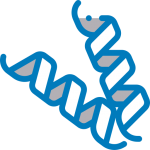
 Human VLDL R Protein, His Tag
Human VLDL R Protein, His Tag
VLR-H5227
100ug
Brand
ACROBiosystems
Description
Source :
Human VLDL R, His Tag (VLR-H5227) is expressed from human 293 cells (HEK293). It contains AA Gly 28 – Ser 769 (Accession # P98155-2).
Molecule : VLDL R
Synonyms : VLDLR,RP11-320E16.1,CHRMQ1,FLJ35024,VLDLRCH,VLDL receptor
Format : Powder
Category : Bio-Markers & CD Antigens
Accession : NP_001018066.1
Storage : -20℃
Shipping condition : Powder,RT
Molecular Weight : 84.0 kDa
Characteristics :
This protein carries a polyhistidine tag at the C-terminus. The protein has a calculated MW of 84.0 kDa. The protein migrates as 90-110 kDa under reducing (R) condition (SDS-PAGE) due to different glycosylation.
Endotoxin Level : Less than 1.0 EU per μg by the LAL method.
Buffer : PBS, pH7.4
Description :
The very-low-density-lipoprotein receptor (VLDL-R) is a lipoprotein receptor that shows considerable similarity to the lowdensity-lipoprotein receptor. VLDL R is a 130 kDa type I transmembrane protein in the LDL receptor family that plays a significant role in lipid metabolism and in nervous system development and function .This receptor has been suggested to be important for the metabolism of apoprotein-E-containing triacylglycerol-rich lipoproteins, such as very-low-densitylipoprotein (VLDL), beta-migrating VLDL and intermediate-density lipoprotein. It is also one of the receptors of reelin, an extracellular matrix protein which regulates the processes of neuronal migration and synaptic plasticity. In humans, the VLDL-R is encoded by the VLDLR gene.
A rare neurological disorder first described in the 1970s under the name “disequilibrium syndrome” is now considered to be caused by the disruption of VLDLR gene. The disorder was renamed VLDLR-associated cerebellar hypoplasia (VLDLRCH) after a 2005 study. It is associated with parental consanguinity and found in secluded communities such as the Hutterites. VLDLRCH is one of the two known genetic disorders caused by a disruption of reelin signaling pathway, along with Norman-Roberts syndrome.
References :
(1) Sakai J, Hoshino A, Takahashi S, et al., 269 (3): 2173–82.
(2) Moheb LA, Tzschach A, Garshasbi M, et al. Eur. J. Hum. Genet. 16 (2): 270–3.
(3) Boycott KM, Flavelle S, Bureau A, et al., 2005, Am. J. Hum. Genet. 77 (3): 477–83.
Application
Reactivity



